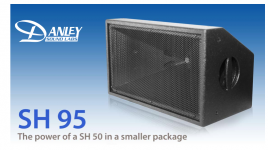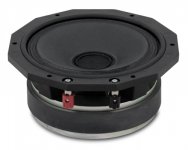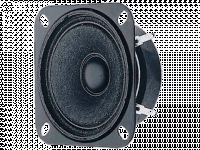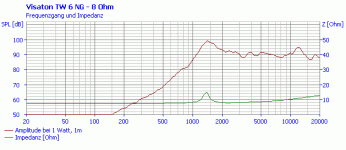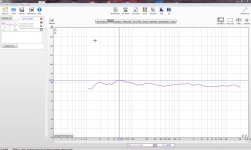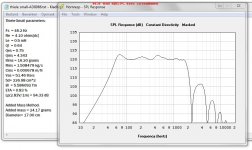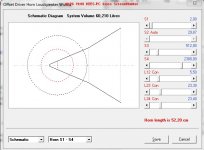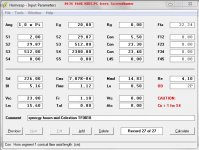good one, thanks
yes, B&C have interesting small drivers
but the small drivers can't handly the power from bass guitar unless they are crossed highish
I am using an 18Sound 8" for mids right now, so I know
can't destroy them with crossover, but they simply distort if not careful with them
I might have a couple of 12" to throw into the mix ... occationally 😀
but this 18" sounds great fullrange, so a good top would make it easier to transport
I might just cross to a BMS 1.5" at 1khz, top make it easy ... but still like to keep the door open for this
yes, B&C have interesting small drivers
but the small drivers can't handly the power from bass guitar unless they are crossed highish
I am using an 18Sound 8" for mids right now, so I know
can't destroy them with crossover, but they simply distort if not careful with them
I might have a couple of 12" to throw into the mix ... occationally 😀
but this 18" sounds great fullrange, so a good top would make it easier to transport
I might just cross to a BMS 1.5" at 1khz, top make it easy ... but still like to keep the door open for this
The output difference between a pair of horn loaded 8" and a front loaded 8" could be as much as 10 dB, like going from 100 watts to 1000 watts, except the speakers don't complain.good one, thanks
yes, B&C have interesting small drivers
but the small drivers can't handly the power from bass guitar unless they are crossed highish
I am using an 18Sound 8" for mids right now, so I know
I had the Alpha 6" in small front loaded boxes before the conical horn arrangement- they were underwhelming.
Using the conical horn/BR they compare well (down to 100 Hz) in output with a 15", but the cabinet is smaller than the usual 15". Pattern control and midrange clarity is better than a 15",
Last edited:
like going from 100 watts to 1000 watts, except the speakers don't complain.
trust me, with bass guitar they will complain, a lot
its like pushing them with a 1000watt
For bass use making the 2 way Synergy wedge shape like the DSL SH-90 (which uses 2 x8" and a 1") would be a good move.
You could do removeable BR port covers for use with or without the sub.
lets stick to that suggestion
 ... I won't need it to be perfect anyway 😉
... I won't need it to be perfect anyway 😉Attachments
wow, a crazy driver
Precision Devices have built a 6" tweeter with underhung voice coil
cool
http://www.precision-devices.com/file-downloads/PD615WGDatasheet240413.pdf
Precision Devices have built a 6" tweeter with underhung voice coil
cool
http://www.precision-devices.com/file-downloads/PD615WGDatasheet240413.pdf
Attachments
The output difference between a pair of horn loaded 8" and a front loaded 8" could be as much as 10 dB, like going from 100 watts to 1000 watts, except the speakers don't complain.
I had the Alpha 6" in small front loaded boxes before the conical horn arrangement- they were underwhelming.
Using the conical horn/BR they compare well (down to 100 Hz) in output with a 15", but the cabinet is smaller than the usual 15". Pattern control and midrange clarity is better than a 15",
I'm actually working on a model with the Alpha 6A (sealed box). It looks very promising using four drivers, adding needed gain to the low end. The Alphas' diaphram displacement is kept just below x-max (3.0mm @ 100Hz hitting 119dB) with the port velocity below 17m/s, port size ø3.15cm. I'm hoping that the port size won't mess up the high frequency with carefull port geometry and placement!
I've modeled the Beta 6A as well. It drops of a tad faster towards the low end, but it has higher power handling and x-max (4.5mm). Furthermore, it shows better roll-off characteristics in the top end, making it easier on the crossover.
Maybe the Beta is the better choice, though it adds $10 a piece!
/Thomas
Last edited:
kees ... we do know about Qts
small mid drivers have high Qts
Patric like to use 2" for his car fi designs
John wants a 4" for use with small tube amps
its only me wanting bigger mid for bass guitar setup
what are your plans regarding the Synergy ? ... just curious
maybe you should go back and read some of Patrick's and John's posts where they explain very detailed what we are facing here ... its not simple
they do not need us to do what they want, its the other way round
Hi
Just a tought of me about the qts, maube I am te much focus on bass drivers there it is more important.
I like the concept of the synergy, mayne a small one for in a home, but I think I stuck with minimum of 2 drivers, or 4 as some want, I will read some more, I will let the QTS rest, did try to explane the speakers when closed the back yourselfs. First I go make the sschematic of the speaker tester so I can go play later with the synergy,, and the fase trouble and filter.
But I read about 2 inch or 4 inch, what to do if I want a synergy who go from 100 hz to 20 khz do I need always a three way then, the Alpha 6A can go from 100 Hz to 5Khz and I like the plot, nice. Then a two way can be made who go from 100 hz.??
anyway I go read some more about it, I am a amp maker and not loudspeakers, I am not new for it but have never did exotic ones.
regards
Last edited:
try google the suggested Danley SH-95, and go to pictures 😱
btw, I'm now thinking about using that PD 6" like a slot loaded horn tweeter 😀
btw, I'm now thinking about using that PD 6" like a slot loaded horn tweeter 😀
wow, a crazy driver
Precision Devices have built a 6" tweeter with underhung voice coil
cool
http://www.precision-devices.com/file-downloads/PD615WGDatasheet240413.pdf
That's a very impressive driver. Its also nice that they are 16 ohms. Too bad they are so expensive. With a pair of them on a Synergy horn you would have to pad them down. The limiting factor on your system sensitivity would be the compression driver's high frequency.
Over on another thread, I voiced some of my complaints about horn speakers.
Specifically, that they tend to sound like a 'giant set of headphones.'
This is nice on good recordings, but on 90% of the garbage that I listen to, I appreciate a speaker that adds some ambience to the recording.
YES I know this is not hifi, but it sounds GOOD.
Take one listen to some of these speakers, and you'll realize that there's a lot of good reasons to have a radiation pattern that isn't 90 degrees:
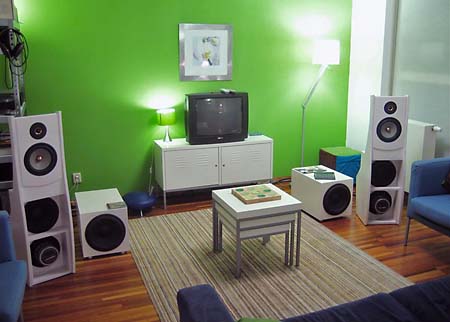
Linkwitz Orion
anything from Vandersteen

Anything from Beolab
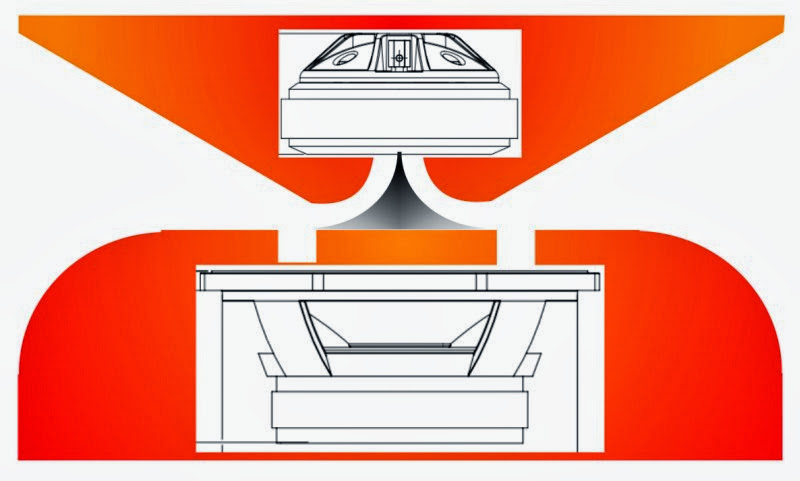
Here's the idea I had. You basically take a Synergy horn and you rotate it on it's axis by 360 degrees. Very similar to the Beolab speakers.
I'm no good with 3D programs, so the 2D picture above is the best that I can do to visualize it.
Here's a list of reasons this might work well:
1) It radiates sound to the front and to the back, similar to the Orion, dipoles like Vandersteen, and cardioids like the Beolab. A lot of people, myself included, find monopoles to sound too clinical
2) One really cool aspect of this is that it solves one of my gripes with horns. Basically, horns with wide horizontal coverage and narrow vertical coverage don't work very well. For instance, if you want a horn with a coverage pattern of 90 degrees horizontally by 45 degrees vertically, the size of the horn gets out of control in a hurry. Paul Spencer published some pics of one that he built that looks like it's the size of a refrigerator. By rotating the horn on the center axis, you get a really big mouth, without taking up a ton of space. For instance, the Lambda Unity Horn has a square mouth that's about 1600 square centimeters, that measures 40cm x 40cm. It has sixty degrees of vertical and horizontal coverage. The horn pictured above has a vertical coverage of just thirty degrees, a horizontal coverage of 360 degrees. The cool thing is that the mouth has an area of over 1800 square centimeters!
Radial horns are a great way to have your cake and eat it too; you get the narrow vertical coverage which sounds good in a living room, but you also get the big mouth that's needed to support the low frequency drivers in a Unity or Synergy horn. If one used a rectangular mouth like the Lambda horn, along with a narrow vertical angle, it would end up huge like this, to achieve the same low frequency support:
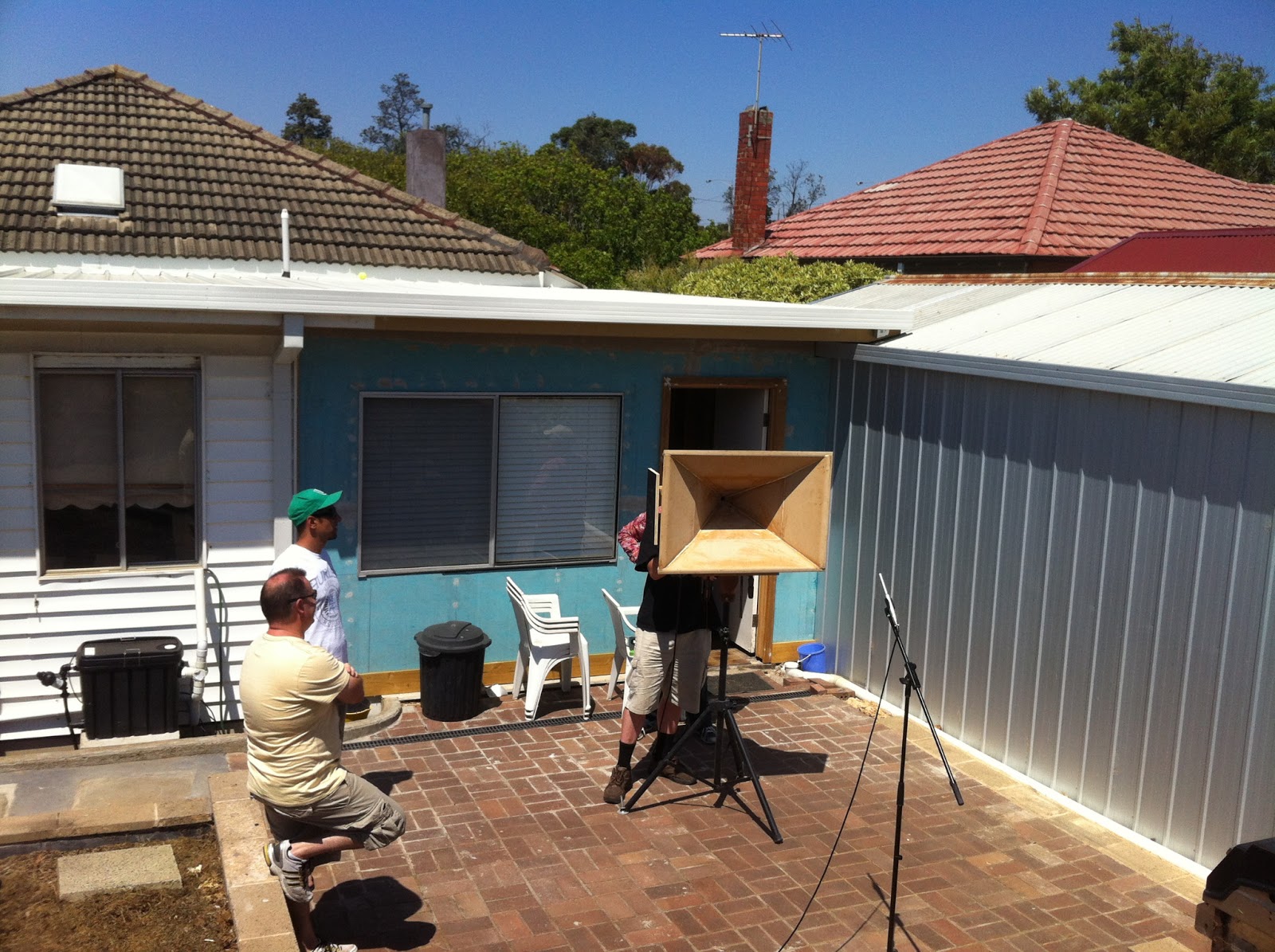
^^^ note the sheer size of that monster
I hope my pic makes sense; my pic just shows a cross section. The horn itself is radial, similar to a Smith horn. But instead of being 135 degrees, it is 360.
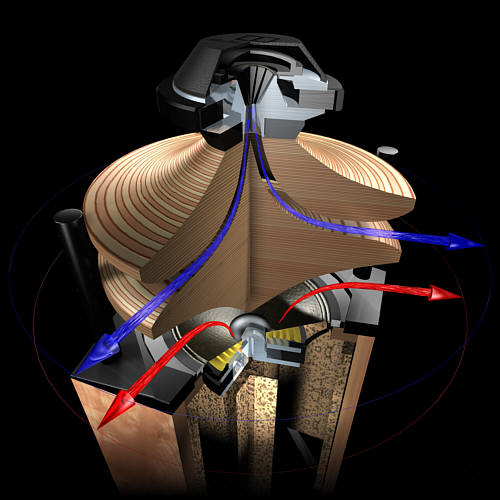
Similar to a Duvel, but only using one horn. And it's conical, not exponential.
OK, still with me?

Here's my last 'tweak' to the design. It's the exact same horn, but I've tilted it back 30 degrees. Here's a list of reasons this would improve imaging:
1) I've listened to the Gradient speakers, and I believe they're on the right track. The gradient speakers are tilted back, and it's designed so that the first reflection off of the ceiling is closer to the listener.
2) Tilting the speaker backwards makes it so that the floor and the ceiling bounce are not symmetrical. This improves imaging.
3) The really cool thing about tilting the speaker back is that the energy radiated backwards goes right into the carpet. It's basically sound absorption that doesn't dominate the living room.
4) 'speakerscott' on the other thread mentioned that the speakers were kinda low for his home theater screen. I have the same issue.
5) One thing I've notice with the SAW lens is that the sound seems to 'float' above the speaker. I believe a big part of the reason that this happens is because the majority of the waveguide is *below* the speaker, not above. We get the same effect when we tilt this horn; the majority of the horn is *below* eye level, not above. But note that the horn mouth is still the same size; it's just been tilted backward by 30 degrees.
Ideally one would build this radial horn with fiberglass and a CAD program, but I think bamboo plates from Ikea and some sontubes make a close approximation:
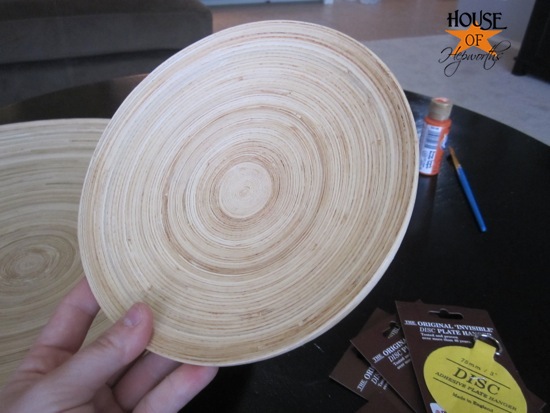
Specifically, that they tend to sound like a 'giant set of headphones.'
This is nice on good recordings, but on 90% of the garbage that I listen to, I appreciate a speaker that adds some ambience to the recording.
YES I know this is not hifi, but it sounds GOOD.
Take one listen to some of these speakers, and you'll realize that there's a lot of good reasons to have a radiation pattern that isn't 90 degrees:

Linkwitz Orion
An externally hosted image should be here but it was not working when we last tested it.
anything from Vandersteen

Anything from Beolab

Here's the idea I had. You basically take a Synergy horn and you rotate it on it's axis by 360 degrees. Very similar to the Beolab speakers.
I'm no good with 3D programs, so the 2D picture above is the best that I can do to visualize it.
Here's a list of reasons this might work well:
1) It radiates sound to the front and to the back, similar to the Orion, dipoles like Vandersteen, and cardioids like the Beolab. A lot of people, myself included, find monopoles to sound too clinical
2) One really cool aspect of this is that it solves one of my gripes with horns. Basically, horns with wide horizontal coverage and narrow vertical coverage don't work very well. For instance, if you want a horn with a coverage pattern of 90 degrees horizontally by 45 degrees vertically, the size of the horn gets out of control in a hurry. Paul Spencer published some pics of one that he built that looks like it's the size of a refrigerator. By rotating the horn on the center axis, you get a really big mouth, without taking up a ton of space. For instance, the Lambda Unity Horn has a square mouth that's about 1600 square centimeters, that measures 40cm x 40cm. It has sixty degrees of vertical and horizontal coverage. The horn pictured above has a vertical coverage of just thirty degrees, a horizontal coverage of 360 degrees. The cool thing is that the mouth has an area of over 1800 square centimeters!
Radial horns are a great way to have your cake and eat it too; you get the narrow vertical coverage which sounds good in a living room, but you also get the big mouth that's needed to support the low frequency drivers in a Unity or Synergy horn. If one used a rectangular mouth like the Lambda horn, along with a narrow vertical angle, it would end up huge like this, to achieve the same low frequency support:
^^^ note the sheer size of that monster
I hope my pic makes sense; my pic just shows a cross section. The horn itself is radial, similar to a Smith horn. But instead of being 135 degrees, it is 360.

Similar to a Duvel, but only using one horn. And it's conical, not exponential.
OK, still with me?

Here's my last 'tweak' to the design. It's the exact same horn, but I've tilted it back 30 degrees. Here's a list of reasons this would improve imaging:
1) I've listened to the Gradient speakers, and I believe they're on the right track. The gradient speakers are tilted back, and it's designed so that the first reflection off of the ceiling is closer to the listener.
2) Tilting the speaker backwards makes it so that the floor and the ceiling bounce are not symmetrical. This improves imaging.
3) The really cool thing about tilting the speaker back is that the energy radiated backwards goes right into the carpet. It's basically sound absorption that doesn't dominate the living room.
4) 'speakerscott' on the other thread mentioned that the speakers were kinda low for his home theater screen. I have the same issue.
5) One thing I've notice with the SAW lens is that the sound seems to 'float' above the speaker. I believe a big part of the reason that this happens is because the majority of the waveguide is *below* the speaker, not above. We get the same effect when we tilt this horn; the majority of the horn is *below* eye level, not above. But note that the horn mouth is still the same size; it's just been tilted backward by 30 degrees.
Ideally one would build this radial horn with fiberglass and a CAD program, but I think bamboo plates from Ikea and some sontubes make a close approximation:

try google the suggested Danley SH-95, and go to pictures 😱
btw, I'm now thinking about using that PD 6" like a slot loaded horn tweeter 😀
Tinitus
Thanks for the advise, I have looked at it, I see that a 8 inch woofers and a compression driver is used in the danly horn, this can work with tapped horns as one whole system nice, but maybe it it is what to big for a home, or to loud for shure, very neat system and technic it is for shure.
For the 8 inch woofer, we need types who do easely 2 Khz for crossover to compression driver, a wide band 8 inch for example.
I did found a tweeter from visaton, this go to 30 Khz (-10dB). I have used it a time ago in a box, I have this speaker for 10 years but it is still available, did sound sweet.. TW 6 NG - 8 Ohm
Maybe you can do something with it as tweeter in stead of the compression driver.
It is for later, I do follow you guys a while and learn further from you.
regards kees
Attachments
Last edited:
Similar to a Duvel, but only using one horn. And it's conical, not exponential.
OK, still with me?
I have always found the Duvel interesting, and cleverly designed
making it a tapped unity is a new interesting angle
but would consider a 180degr version
Tinitus
Thanks for the advise, I have looked at it ...
Maybe you can do something with it as tweeter in stead of the compression driver.
I'm interested in a mono speaker for instruments
I might think differently if it were for home hifi
but seems the choice of drivers depends a lot on how its going to be used
There is a big difference between instrumentation speakers and home hifi afcourse, for me high end is important, I do use hybrid amps who I design (tube/mosfet dc coupled no feedback version.) speakers is quite new, better, now new but not so high class of science what you guys put here but after some playing with speakers I did get interested and yes, it is more complicated science as a design of a amplifier, we need low bass, high upper freq, that is very complicated to do it right (fase/delay/room).
Did I post this picture here? it is my present T-TQWT/open baffle system going to 16 Hz as lowest frequenty measured in my room.
Did I post this picture here? it is my present T-TQWT/open baffle system going to 16 Hz as lowest frequenty measured in my room.
Attachments
please, we need to try and stay on the thread topic, or it all ends in a mess
Nod...
I hope Patrick doesn't mind if I jump in here with the real experts for one quick question, sort of relavant. in leiu of and waiting to buil/aquire a Synergy horn I was thinking of throwing that very cool Eminence Alpha mid driver into the mouth of a similar 60 degree conical horn and using it up from around 500hz to as high as I can before passing it on to a APT50 type horn on top and a "Lascala" type FH1 Peavey bottom I have on hand , is that ( with a DCX2496 crossover a given ) a good plan?
A Synergy with a pair of Alpha 6A (or 8A) and HF driver would allow a crossover point of around 100 Hz to the 18" woofer, which means the woofer placement is not very critical, as it would be if you were using it up to 500 Hz.
If you want to spend more money there are better B&C cones.
For bass use making the 2 way Synergy wedge shape like the DSL SH-90 (which uses 2 x8" and a 1") would be a good move.
You could do removeable BR port covers for use with or without the sub.
Last edited:
I was thinking of throwing that very cool Eminence Alpha mid driver into the mouth of a similar 60 degree conical horn and using it up from around 500hz to as high as I can before passing it on to a APT50 type horn on top ....
regarding Alpha 6 in conical horn, maybe Art/weltersys can help you
Hi all.
Yes you are right, stay on focus.
Okay, I have here some very old phillips 8 inches, and did a sim in hornresp.
Looks that these do quite well, but hey it is my first attemt to get some nice graph.
I have measured the thiel small parameters from this driver see pictures.
Only is the horn not what to big? I did need a synergy who go to 90 a 100 hz graph
go even lower. I did see the schematic of hornresp let see a different horn in compare
with the original synergy, but I can do it so it will match but then I get more ripple.
regards
kees
Yes you are right, stay on focus.
Okay, I have here some very old phillips 8 inches, and did a sim in hornresp.
Looks that these do quite well, but hey it is my first attemt to get some nice graph.
I have measured the thiel small parameters from this driver see pictures.
Only is the horn not what to big? I did need a synergy who go to 90 a 100 hz graph
go even lower. I did see the schematic of hornresp let see a different horn in compare
with the original synergy, but I can do it so it will match but then I get more ripple.
regards
kees
Attachments
Last edited:
Sorry, mid drivers are mounted near the throat, not the mouth of a horn 😉.in leiu of and waiting to buil/aquire a Synergy horn I was thinking of throwing that very cool Eminence Alpha mid driver into the mouth of a similar 60 degree conical horn and using it up from around 500hz to as high as I can before passing it on to a APT50 type horn on top and a "Lascala" type FH1 Peavey bottom I have on hand , is that ( with a DCX2496 crossover a given ) a good plan?
Assuming you are planning to emulate a Synergy horn, the APT would go on the throat, and the mid drivers mounted on the side of the horn feeding through port holes near the throat.
The path length difference between the FH1 and the mid/hi horn will be a problem at 500 Hz, though if you used the Alpha 6A down to around 100 Hz, other than needing time alignment (requiring DSP), the FH1 would "work" for another octave.
As I mentioned in post #1170, the APT won't go low enough for a cross to an offset horn Alpha 6A, which is why I did the design linked in #1177.
Using a small diaphragm driver like the APT will require a smaller ( like 3-4") mid driver for an effective Synergy type arrangement.
Sorry, I meant throat. So I will simply stuck with the Peavey CH1@ 500hz and standard 3way "Lascala plan crossing at 7-8k
To apt 50. Back to the the "Big S" school.
To apt 50. Back to the the "Big S" school.
Hi all.
Yes you are right, stay on focus.
Okay, I have here some very old phillips 8 inches, and did a sim in hornresp.
Looks that these do quite well, but hey it is my first attemt to get some nice graph.
I have measured the thiel small parameters from this driver see pictures.
Only is the horn not what to big? I did need a synergy who go to 90 a 100 hz graph
go even lower. I did see the schematic of hornresp let see a different horn in compare
with the original synergy, but I can do it so it will match but then I get more ripple.
regards
kees
How do you plan to get the mids within 5.5cm of the throat? Try drawing the actual horn out with the drivers you plan to use and tell me if it can be physically built. I ask this only because I've simulated a lot of very nice horns to only find out I couldn't build what I simulated.
- Home
- Loudspeakers
- Multi-Way
- Suitable midrange cone, for bandpass mid in Unity horn
